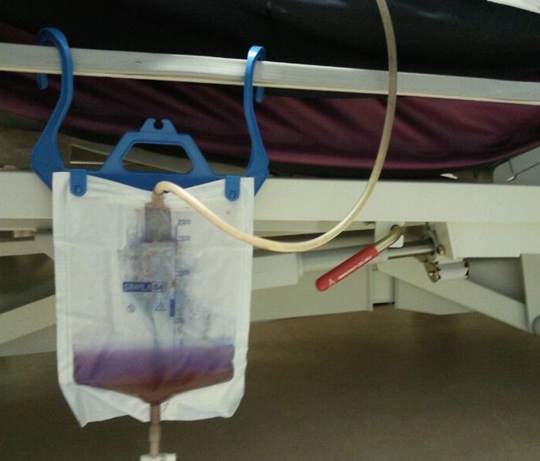Medicine in Pictures: Purple Urine Bag Syndrome
Capt Gary Chow, Katerina Achilleos and Col Hem Goshai
Cite this article as: BJMP 2011;4(4):a444
|
An 86-year-old lady was admitted from her residential home with acute on chronic confusion, new symptoms of expressive and receptive dysphasia, dysphagia, vacant episodes and urinary incontinence. She had a previous significant history of haemorrhagic stroke with residual right sided weakness, atrial fibrillation, hypertension, and moderate dementia. Following a CT head, this lady was started on acyclovir for encephalitis. She failed to respond to treatment, and developed constipation. With careful consideration of her poor prognosis and quality of life, this lady was placed on the End of Life Pathway. She was catheterised for comfort. Nine days after initial insertion of the urinary catheter, purple urine was noted in the catheter bag with yellow urine in the tubing leading to the bag. Urine dipstick showed Blood ++, Protein ++, Leuc +, Nit –ve, Glu -ve, Ketone +, pH 8.0. Urine microscopy showed: WCC 454, RBC 279, epithelial cells 52, no casts. Urine culture revealed heavy mixed growth with multiple organisms.

Question: What is the diagnosis?
Answers:
- Porphyria
- Propofol infusion syndrome
- Purple urine bag syndrome
- Blue diaper syndrome
Differential diagnoses: Discoloration of urine can be caused by trauma if blood stained, urinary tract infections, ingestion of dye (methylene blue), medications (amitriptyline, indomethacin, triamterene, flutamide, and phenol).
Explanation:
Porphyria usually presents with severe pain with neuropsychological symptoms or photosensitivity, and urine discoloration is likely to occur from initial onset of disease.
Propofol is an anaesthetic agent, excreted in the urine as phenol derivatives which can cause a green urine discolouration1. This medication is unlicensed for End of Life Pathway. Propofol infusion syndrome is associated with prolonged high dose infusion, but is not always accompanied by urine discoloration.
Blue diaper syndrome is an inherited metabolic disorder of tryptophan with presentation at infancy2-3.
Correct answer
Purple urine bag syndrome (PUBS)
Purple urine bag syndrome (PUBS)
PUBS is an uncommon condition with purple discoloration of the urine catheter system. This phenomenon is due to the presence of indigo and indirubin in the collected urine. PUBS was first published in 19784. Some academics would argue that PUBS was reported even earlier historically as an observation in Sir Henry Halford's bulletin in 18115-6. Two recent literature reviews suggested the prevalence of PUBS is as high as 9.8% in institutionalized patients with long-term urinary catheterisation8-9, 12.
A triad of key factors are suggested as cause of PUBS:
- high level of tryptophan in the gut due to diet intake or bowel stasis
- long term catheterisation8
- urinary tract infection (UTI) with bacteria possessing indoxyl phosphatase and sulphatase enzymes, commonly Providencia stuarttiand rettgeri, Pseudomonas auruginosa, Proteus mirabilis, Escherichia coli, Klebsiella pneumoniae, Morganella, Citrobacter species, Group BStreptococci and Enterococci8, 13.
It is understood that bowel stasis causes accumulation of tryptophan, which leads to an increase in urinary indoxyl sulphate (UIS). In the presence of indoxyl phosphatase and sulphatase enzyme activities, whilst collected in the catheter system, UIS is degraded to form a mixture of indigo and dissolved indirubin in the plastic11, coating the catheter system with a purple appearance. Intensity of discoloration is deeper the longer the urine is in contact with the catheter plastic7, 10-12. The urine does not appear purple prior to entering the catheter.
Recent literature7-8 also suggested female gender, alkaline urine, bed bound debilitated patient population, PVC material7 and institutionalization are further predisposing factors of PUBS.
Management of PUBS requires catheter change and treatment of underlying UTI.
Good catheter hygiene and shorter duration of catheterisation can reduce PUBS1.
|
Competing Interests None declared Author Details Capt GARY CHOW, Medical Officer, 2 Medical Regiment, Glyn Hughs Bks, Hohne. KATERINA ACHILLEOS, MBBS BSc(Hons) MRCP, CT2 Acute Medicine, Southend University Hospital, UK. Col HEM GOSHAI, MBE MBCHB BSc, Garrison Clinical Director, Hohne Garrison. CORRESPONDENCE: Capt GARY CHOW, Medical Officer, 2 Medical Regiment, Glyn Hughs Brks, Hohne, BFPO 30. Email: ha02068@doctors.org.uk |
References
- Foot C, Fraser JF. Uroscopic Rainbow: Modern Matula Medicine. Postgrad Med J 2006;82(964):126–129.
- Drummond K, Miachael A, Ulstrom R, et al. The Blue Diaper Syndrome: Familial Hypercalcemia with Nephrocalcinosis and Indicanuria; A new familial disease, with definition of the metabolic abnormality. Am J Med. 1964 Dec;37:928-48.
- Cochat P, Pichault V, Bacchetta J, et al. NephrolithiasisRelated to Inborn Metabolic Diseases. Pediatr Nephrol 2010;25(3):415–424.
- Barlow G, Dickson J. Purple Urine Bags. Lancet 1978;1:220-221.
- Arnold W. King George III's Urine and Indigo Blue. Lancet 1996;347:1811-1813.
- Macalpine I, Hunter R. The "Insanity" of King George III: A Classic Case of Porphyria. BMJ 1966;1:65-71.
- Su F, Chung S, Chen MH, et al. Case Analysis of Purple Urine-Bag Syndrome at a Long-Term Care Service in a Community Hospital. Chang Gung Med J 2005;28:636-642.
- Khan F, Chaudhry M, Qureshi N, et al. PurpleUrine Bag Syndrome: An Alarming Hue? A Brief Review of the Literature. Int J Nephrol. 2011;2011:419213.
- Dealler S, Belfield P, Bedford M, et al. Purple Urine Bags. J Urol1989;142(3):769–770.
- Al-Sardar H, Haroon D, Purple urinary bag syndrome. Am J Med 2009;122(10):e1-2.
- Dealler S, Hawkey P, Millar M. Enzymatic Degradation of Urinary Indoxyl Sulfate by Providencia Stuartii and Klebsiella Pneumoniae Causes the Purple Urine Bag Syndrome. J Clin Microbiol 1988;26:2152-2156.
- Lin C, Huang H, Chien C, et al. Purple Urine Bag Syndrome in Nursing Homes: Ten Elderly Case Reports and a Literature Review. Clin Interv Aging 2008;3(4):729-734.
- Vallego-Manzur F, Mireles-Cabodevila E, Varon J. Purple Urine Bag Syndrome. Am J Emerg Med 2005;23:521-524.

The above article is licensed under a Creative Commons Attribution-NonCommercial-NoDerivatives 4.0 International License.




